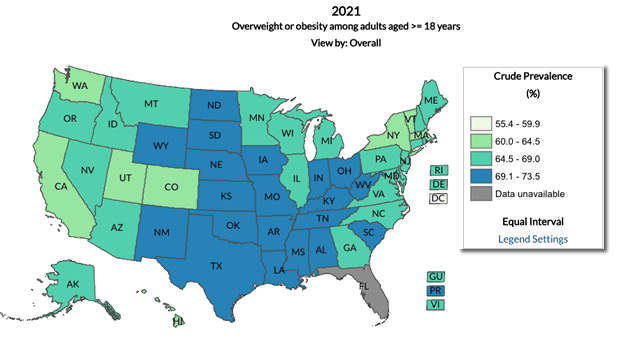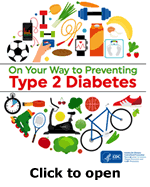

Centers for Disease Control and Prevention, National Center for Chronic Disease Prevention and Health Promotion, Division of Population Health. Chronic Disease Indicators (CDI) Data [online]. [accessed Jul 31, 2023]. URL:https://nccd.cdc.gov/cdi
Lifestyle and nutritional choices have been known to delay or prevent the development type II diabetes for many years. Simmons, Harding et al. found an inverse relationship between achievement of five life changes and the progression from pre-diabetes to diabetes. Study participants who were able to meet five goals prevented or significantly delayed the onset of diabetes.
 Of course the challenge is meeting these health goals and maintaining their benefits. Perhaps the easiest, and possibly the best way to introduce the subject of T2DM prevention is to coordinate your patient teaching with commonly available CDC and ADA infographics. By familiarizing yourself with these available learning aides you may be able to leverage their investment in the National Diabetes Prevention Program. Their evidence-based lifestyle change programs can reduce participants risk of T2DM. Click the example.
Of course the challenge is meeting these health goals and maintaining their benefits. Perhaps the easiest, and possibly the best way to introduce the subject of T2DM prevention is to coordinate your patient teaching with commonly available CDC and ADA infographics. By familiarizing yourself with these available learning aides you may be able to leverage their investment in the National Diabetes Prevention Program. Their evidence-based lifestyle change programs can reduce participants risk of T2DM. Click the example.
The CDC, Medicare and the American Diabetes Association (ADA) supports the use of medical nutrition therapy (MNT) as part of a multidisciplinary approach in the treatment of diabetes. MNT applies nutrition and behavioral science to treat a specific physical condition. MNT for diabetes includes assessment of the patient's nutritional status and the collaborative development and implementation of an individualized diabetes self-management plan. The ADA also recommends "a registered dietitian, knowledgeable and skilled in MNT, should serve as an inpatient team member.
The dietitian is responsible for integrating information about the patient's clinical condition, eating, and lifestyle habits and for establishing treatment goals in order to determine a realistic plan for nutrition therapy". In the outpatient setting the Registered Dietician assists the patient to determine nutritional needs based upon desired weight, lifestyle, medication, and comorbidities, such as hypercholesterolemia, hypertension, renal or liver disease, etc. The diabetes nurse educator can assist the patient to incorporate knowledge and behaviors into daily diabetes self-care.
| Adapted from The American Diabetes Association (ADA) Standards of Care in Diabetes - 2023 | |
| Effectiveness of nutrition therapy | 5.10 The (ADA) Standards of Care in Diabetes - 2023 recommend: individualized medical nutrition therapy by a registered dietitian nutritionist with expertise in diabetes care for individuals with type 1 or type 2 diabetes, prediabetes, and gestational diabetes mellitus. 5.11 Ensure adequate reimbursement for diabetes medical nutrition therapy by insurance and other payers due to its potential for cost savings and improved cardiometabolic outcomes. |
| Energy balance | Recommend behavioral modification to achieve and maintain at least a 5% weight loss for all individuals with overweight or obesity. |
| Eating patterns and macronutrient distribution |
There is no single ideal macronutrient pattern for people with diabetes; Individualize meal plans for people with diabetes while considering nutrient quality, total calorie, and metabolic goals. Discuss various eating patterns for managing type 2 diabetes and preventing prediabetes Reduce overall carbohydrate intake to improve glycemia for individuals with diabetes, and adapt their eating patterns to meet their individual needs and preferences. |
| Carbohydrates | Emphasize carbohydrate sources that are nutrient-dense, high in fiber (at least 14 g fiber per 1000 kcal), and minimally processed. Emphasize nonstarchy vegetables, fruits, legumes, whole grains, and dairy products with minimal added sugars. Replace sugary drinks with water or low/no calorie beverages to control blood sugar, manage weight, and reduce the risk of cardiovascular disease and fatty liver. Limit consumption of added sugar foods to prioritize nutrient-dense options. Personalize education regarding the glycemic impact of carbohydrates, fats, and proteins with attention to to optimize mealtime insulin dosing in flexible insulin therapy. Educate individuals on the importance of consistent carbohydrate intake patterns (time and amount) when using a fixed insulin doses to improve glycemia and reduce hypoglycemia risk. |
| Protein | T2DM persons experiencing hypoglycemia should avoid high-protein carbohydrate sources like beans, lentils, and other pulses because the protein can increase insulin response and exaccerbate hypoglycemia. |
| Dietary Fat | A Mediterranean-style eating plan with healthy n-3 long-chain polyunsaturated fatty acids (n-3 LCPUFA) may improve glucose metabolism and reduce cardiovascular disease risk. |
| Micronutrients and herbal supplements |
There is no clear evidence that dietary supplementation with vitamins, minerals (such as chromium and vitamin D), herbs, or spices (such as cinnamon or aloe vera) can improve outcomes in people with diabetes who do not have underlying deficiencies, and they are not generally recommended for glycemic control. There may be evidence of harm for certain individuals with β carotene supplementation. |
| Alcohol | Adults with diabetes who drink alcohol should do so in moderation (no more than one drink per day for adult women and no more than two drinks per day for adult men). Educate individuals with diabetes about alcohol-related delayed hypoglycemia, especially those on insulin or insulin secretagogues. Emphasize glucose monitoring after drinking alcohol to reduce the risk of hypoglycemia. |
| Sodium | Limited to 2,300 mg/day. Excessive sodium has been associated with hypertension, cardiovascular disease and kidney disease, all of which are exaccerbated by diabetes. |
| Nonnutritive sweeteners |
Nonnutritive sweeteners as a sugar replacement can lower calorie and carbohydrate intake, but be mindful of not compensating with increased energy intake from other sources. Consider low- and no-calorie sweetened beverages can substitute for some water. |
Instant
Feedback:
Development of type 2 diabetes may be delayed or prevented by lifestyle changes.
References
Ada diabetes standards of care 2023 guideline summary. Guideline Central. (2021, July 22). https://www.guidelinecentral.com/guideline/14119/#section-anchor-1226429
Diabetesjournals.org. (n.d.). https://diabetesjournals.org/care/article/46/Supplement_1/S68/148055/5-Facilitating-Positive-Health-Behaviors-and-Well
Hales C.M., Carroll M.D., Fryar C.D., Ogden C.L., (2020). Prevalence of Obesity and Severe Obesity Among Adults: United States, 2017–2018. U.S. DEPARTMENT OF HEALTH AND HUMAN SERVICES. Centers for Disease Control and Prevention. National Center for Health Statistics. NCHS Data Brief No. 360. February 2020 https://www.cdc.gov/nchs/data/databriefs/db360-h.pdf
Simmons, R., Harding, A. et al. (2006) How much might achievement of diabetes prevention behavior goals reduce the incidence of diabetes if implemented at the population level? Diabetologia. 49(5).
Van Dael P. (2021). Role of n-3 long-chain polyunsaturated fatty acids in human nutrition and health: review of recent studies and recommendations. Nutrition research and practice, 15(2), 137–159. https://doi.org/10.4162/nrp.2021.15.2.137